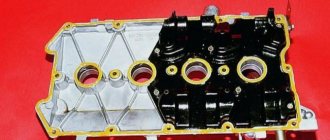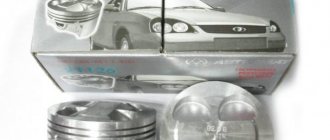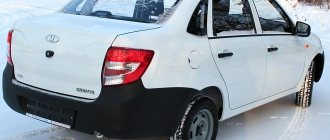Appearance
Few people know, but the first prototype of the Priora was presented to the public back in 2003. It was then that AvtoVAZ presented a new sedan with the index 2170. Since then, the appearance of the car has remained virtually unchanged, with the exception of the absence of black modlings. So, since 2007, the car was produced in the following guise (see photo below).
The design of the car has become a little fresher than the “tens”. But the exterior cannot be called modern or expressive. Reviews say that the car does not stand out from the crowd. The appearance itself borders on foreign cars from the mid-nineties. So, at the front, AvtoVAZ used round halogen optics and a simple bumper with small fog lights. Unlike the “ten”, the “Priora” (sedan) received a different design for the wings and rear roof pillar. Thanks to this, the car does not seem so angular and “clumsy”. By the way, in the Priora there are no such runs in the gaps as in the VAZ-2110. The design of the side mirrors has also changed. They are now painted in body color and come with LED turn signals. The manufacturer understood that the appearance of the car was not modern. Therefore, in 2011 the car underwent cosmetic changes.
After restyling, the car received a new bumper, which became more prominent, and a radiator grille. The latter took on a diamond shape and received a chrome edging. By the way, the most popular color of the Priora (sedan) car is black.
Lada Priora
Lada Priora is a family of passenger cars produced by.
The model has the factory index VAZ-2170. Production of the machines began in 2007. In March 2007, the manufacturer produced more than a thousand units of Lada Priora sedan. In April, the car went on public sale. Almost a year later, the production of hatchback cars began. And in October 2008, a modification with a station wagon body debuted at the motor show in Krasnodar. The production of this model began in May 2009. In addition to the indicated versions of cars, AvtoVAZ also produces the Lada Priora in a coupe body, but the production volumes of this model are quite small. Another small-scale model is Lada Priora Premier. This car is a version of the sedan extended by 17.5 centimeters. It has been produced in Togliatti since 2008. The model is equipped with a 1.8-liter engine with a capacity of 100 horsepower. Based on the coupe, it was planned to create a car with a convertible body. At the beginning of 2009, the Lada Priora family completely replaced the Lada 110 series from production. The production of station wagons was launched on the freed conveyors. The manufacturer plans to begin production of the next generation Lada Priora in 2020. The Lada Priora Coupe, which has the factory designation VAZ-2172, is a small-scale AvtoVAZ model produced in a three-door hatchback body.
The car is designed on the Lada Priora platform. The car should replace the VAZ-21123 model. Production of the Priora as a three-door hatchback began in 2010. The original Priora sedan has been produced since 2007. The first five-door hatchback rolled off the assembly line only a year later. For the new car, the designers developed more than 150 original elements, including frame parts, front doors, glass, wheels, and so on. The car received folding front seat backs, and the seats themselves were reinforced. To produce the car, AvtoVAZ pilot production was involved. Previously, the predecessor of the Priora Coupe was produced here, from which the car differs in a more comfortable interior, a more powerful engine and expanded equipment. Before launching into mass production, the Lada Priora Coupe was subjected to tests. It is reported that the crash test performance fully meets the standards adopted in Russia. Based on this model, the manufacturer planned to create a convertible.
Body problems
Every motorist knows how poorly protected the “ten” is from corrosion. She was literally rotting before our eyes. Just two years later, saffron milk caps and beetles appeared on the paintwork. "Priora" is just a modified version of the VAZ-2110. But has this ailment been eliminated in her? As operating experience shows, the car is also susceptible to corrosion (although not to the same extent as the “ten”). No matter what color the Priora (sedan) is, after three years blisters form on the enamel. Wheel arches and sills are especially susceptible to this. Another problem that Priora owners face is water in the trunk. According to the manufacturer, this problem can be cured by removing the factory condensate drain plugs.
Review of Lada Priora 217030 - 2008
I purchased my car in November 2008, the mileage today is 26,000 km. Why Priora, because there wasn’t enough money for a foreign car, like, I think, other happy owners of this self-propelled chassis. The first impression was quite good, it was still a new car, but the feeling of joy was overshadowed by two unpleasant creaks. One came from the passenger door (to eliminate it, I had to remove the door trim and put cambrics on all the rods). Another creaking sound came from somewhere behind, and I had to spend some time searching for it. It turned out that it was all in the rear parcel shelf. Glory to the domestic automobile industry and brilliant designers, because only in Russia can they think of putting a plastic shelf on a plastic bracket and hoping for silence in the cabin. Nowadays, squeaks in the car live on their own, they will appear out of nowhere, then disappear, and fighting them, in my opinion, is a waste of time.
Having driven about 1000 km, I noticed one pattern: when any front wheel is sharply lowered (driving over a railway crossing or just driving into a hole), there is an unpleasant blow to the body. I went to the service station, they said that this is the normal operation of domestic racks, and again glory to the domestic trough construction and brilliant designers.
Since I only drive, I can discuss the interior as a driver, although everyone I gave a lift to everyone complained about the lack of space. So, the interior is generally not bad, but what did you want for 308,000, but as for individual details, that is a topic for discussion. Firstly, for some reason all the self-tapping screws stick out with their caps, it’s impossible to install some kind of rivets, and during use they turn out and fall on the rug, then you have to look for where they fell out from and wrap them up.
And the glove compartment, oh horror, close it and never open it, all the guts in it stick out for everyone to see, and there’s really nothing you can put in it, it’s kind of awkward. But I like the on-board computer, there’s a lot of information, it’s very convenient.
The trunk is simply obscenely huge, 4 wheels fit freely, and you can also fold the seats and make one space with the interior, this is also a plus, but when installing the seats back, we again remember our ingenious designers, where are the Japanese, only ours guessed to open the locks holding seat backs, tie some strings that need to be constantly adjusted when installing the backrest.
Otherwise, you are guaranteed 2 hours of puzzles on digging out a rope (tested on yourself), where are the Japanese with their buttons. Despite the size of the trunk, do not rush to load bricks into it, first study where you can put them, otherwise everything will fall into secret niches, especially at the edges, where everything is kept on parole.
Somehow I decided to change the wheels myself from winter to summer, in principle, nothing complicated, I changed them on a Zhiguli 1000 times, but this was on a Zhiguli, then the designers were not as brilliant as they are now. Firstly, the jack doesn’t fit at all and constantly tries to throw the car down, but with such and such a mother, I still lifted the car and wanted to unscrew the wheel, but that was not the case, and I would also express my gratitude to AvtoVAZ, the world leader in the production of metal troughs, Only in Russia can the bolts be set to 17 and the key set to 19.
As for sound insulation, I can’t say anything bad or good, because how can you discuss a thing that simply doesn’t exist!!! Now the engine. I like the engine, it has never let me down yet. Fuel consumption is approximately 6-7 liters per hundred. 98 horses is almost 100, but the tax is less.
At -30 it starts easily. But it won’t be possible to heat the engine to 90 in the winter, 80 is a limit, and even then I completely closed the radiator, but it’s 60-70, and the point here is not the serviceability of the thermostat, but especially its operation, as I was told at the service station. But the muffler is useless, it rumbles like a tractor.
So my verdict: if you need a family car for long trips, take some foreign car, and if you need a car for work, to drive stupidly, not paying attention to small squeaks, then go for it!
Author: Alexander newmpv.ru Review written 2011-05-23
Ground clearance and dimensions of the Priora (sedan)
Judging by the dimensions, the car borders between the C- and B-class. Thus, the body length is 4.35 meters, width – 1.68, height – 1.42 meters. Ground clearance is one of the main advantages of Priora. Thus, the ground clearance on standard 14-inch wheels is 16 and a half centimeters. Along with this, the car has high departure and approach angles. If you do not change the suspension configuration (lower), you can confidently drive this car on the road outside the asphalt surface. The ground clearance is perfectly adapted to our road conditions.
Salon
The interior design can also hardly be called modern. The front panel architecture is reminiscent of the old Ford Mondeo. The center console is silver, with mechanical heater controls and an analog clock. There is also a plug for the radio, which is not installed here from the factory. Four-spoke steering wheel with airbag. The instrument panel contains a minimal set of scales and indicators. By the way, the odometer here is digital. The illumination at night is green and does not dazzle the eyes. Visibility of the Lada Priora (sedan) is at a decent level - the pillars do not form blind spots, the mirrors are quite informative. By the way, the mirrors no longer use blue coating, as on the “tens”, which greatly interfered with visibility.
The architecture of the seats is reminiscent of the “ten”. There is still a lack of normal lateral support here. The door cards have changed in appearance, and a niche has appeared on them for small items.
Most of the complaints are about the build quality of the interior. In the Priora, as in other VAZs, there is practically no sound insulation and very hard, creaking plastic is used. The noise from the engine and arches can be heard after 30 kilometers per hour. To eliminate this problem, the owners provide additional sound insulation. Moreover, “Shumka” is done everywhere: on the roof, on the floor, in the doors and even in the trunk. As operating experience shows, additional sizing can significantly reduce noise inside the car.
Note that in the luxury configuration, the Priora (sedan) car is equipped with air conditioning, electric mirrors and power windows. But as operating experience shows, these mechanisms can fail. In order for the air conditioner to work properly, you need to check the system for leaks every two to three years and refill freon. The power windows also refuse to work. There are several reasons for this. This is a burnt out electric motor, lack of lubrication on the rack of the window lowering mechanism, or oxidized contacts on the block itself. Often the window regulator starts to work poorly for the second reason. The solution to the problem is simple - disassemble the door panel and lubricate the guides on the rail.
Priora station wagon
The extended modification of the car is worth a detailed description. The car is also equipped with a 1.6-liter engine producing 106 hp. pp., but there are also significant differences that the Lada Priora station wagon already has in its basic version.
It is quite natural that the version is more aimed at those car enthusiasts who need space, but not at the expense of reliability. The station wagon has the longest body, which is also reflected in the trunk capacity - for example, if the hatchback has a displacement of only 705 liters, then in the case of the extended version the capacity is 777 liters.
But there are other features that the Lada Priora is endowed with. Technical characteristics in the form of a 106-horsepower engine and a manual gearbox provided the car with economical fuel consumption. Again, unlike the sedan and hatchback, this version in the city consumes only 8.5 liters. However, suburban figures remained the same - 5.5 liters.
Prices for VAZ cars vary greatly across the country. At the same time, the Lada Priora, whose price is 350 thousand rubles, can match the quality of more expensive copies costing 400 thousand. If we take the average figures recommended by the manufacturer, their level rises.
The basic configuration is a 98 liter hatchback. With. is estimated at 454 thousand. An additional package of options will add another 3 thousand to this amount. Option for 106 liters. With. in a luxury version, provided with advanced functionality, it will cost 540 thousand.
The sedan version is also close to these prices - in particular, the Lada Priora, the technical characteristics of which are determined by the 98-horsepower engine and 5-speed manual transmission, is available for 457 thousand. The luxury specification, equipped with a 106-horsepower engine and complemented by a set of options, costs 532 thousand.
Station wagon with 98 hp engine. With. the standard configuration will cost 457 thousand. A more prestigious variation of the car with an engine developing 106 hp. s., sold for 537 thousand.
Specifications
The Lada Priora engine line consists of several in-line four-cylinder units. All of them are gasoline and have distributed fuel injection. Some people mistakenly think that the Priora’s engine is identical to the internal combustion engine of the “two-wheeler”. But that's not true. They are similar in appearance, but their piston group is different.
The base for the Priora sedan is a 1.6-liter injection engine with a 16-valve head. This engine produces 98 horsepower. The torque of the agergat is 145 Nm at four thousand revolutions. This engine is equipped with a non-alternative five-speed manual transmission and accelerates the car to hundreds in 11.7 seconds. The maximum speed is 183 kilometers per hour.
An engine with 106 horsepower is available in luxury trim levels. What is noteworthy is that its working volume is also 1.6 liters. The head is 16-valve, with a timing belt drive. The engine accelerates the car to hundreds in 11 and a half seconds. The maximum speed does not exceed 185 kilometers per hour. But for many these characteristics are not enough. The owners perform chip tuning, install a stinger, a new spider and a direct-flow muffler. “Priora” (sedan) after these modifications becomes a little more powerful. But with proper tuning, this figure does not exceed ten percent. Therefore, only avid fans can refine the VAZ engine.
Length of Priora sedan in meters
Body type
number of seats/doors:
- Sedan - 5/4;
- Station wagon - 5/5;
- Hatchback - 5/5.
Weight
curb weight/gross weight:
- Sedan - 1088/1578 kg;
- Station wagon - 1088/1593 kg;
- Hatchback - 1088/1578 kg.
Engine:
- Type - gasoline, four-stroke;
- Model - 21126;
- Number of valves - 16;
- Working volume - 1596 cm3;
- Cylinder diameter - 82.0 mm;
- Piston stroke - 75.6 mm;
- Maximum power (5600 rpm) - 72 kW;
- Maximum torque (4000 rpm) - 145 Nm;
- Toxicity standards - Euro 3, Euro 4;
- Gasoline - AI-95.
Transmission:
- Type - 4x2, with front-wheel drive and cross-axle differential;
- Transmission - 5-speed;
- Gear ratios:
- First gear - 3.640;
- Second gear - 1.95;
- Third gear - 1.36;
- Fourth gear - 0.94;
- Fifth gear - 0.78;
- Reverse - 3.50.
- Main gear - 3.70;
- Tires, wheels:
- 185/65R14 (5.5J);
- 185/60R14 (5.0-6.0J)
- Speed index - H (210 km/h).
- Length:
Dimensions:
- Sedan - 4350 mm;
- Station wagon - 4330 mm;
- Hatchback - 4240 mm.
Performance indicators:
- Maximum speed - 183 km/h;
- Acceleration time to 100 km/h - 11.5 seconds;
- Fuel consumption (l/100km):
- city - 9.8;
- track - 5.6;
- mixed cycle - 7.2.
Nominal filling volumes:
- Fuel tank - 44 l;
- Engine lubrication system - 3.5 l;
- Engine cooling system - 7.84 l;
- Gearbox - 3.1 l;
- Hydraulic brake system - 0.45 l;
- Windshield washer reservoir - 2.5 l.
note
In 2020, AvtoVAZ produced the latest series of Priora. And in order to reduce the cost of production at the plant, they decided to replace the 98-horsepower engine with an old 8-valve engine developing 87 horsepower. This “Priora” did not shine with good acceleration dynamics. She reached a hundred in 12 and a half seconds. And the maximum speed was limited to 176 kilometers per hour. The only plus is low fuel consumption. In the combined cycle, the 87-horsepower Priora (sedan) consumes seven and a half liters of gasoline.
Technical characteristics of Lada Priora I station wagon
Performance characteristics of Lada Priora station wagon 1st generation
Maximum speed: 183 km/h Acceleration time to 100 km/h: 11.5 sec Fuel consumption per 100 km in the city: 9.8 l Fuel consumption per 100 km on the highway: 5.6 l Fuel consumption per 100 km in the combined cycle: 7.2 l Fuel tank volume: 43 l Vehicle curb weight: 1088 kg Permissible gross weight: 1593 kg Tire sizes: 175/65 R14, 185/65 R14, 185/60 R14
Engine modifications
Engine characteristics
Location: front, transverse Engine capacity: 1596 cm3 Engine power: 98 hp Number of revolutions: 5600 Torque: 145/4000 N*m Power system: Distributed injection (multipoint) Turbocharging: no Cylinder arrangement: In-line Number of cylinders: 4 Cylinder diameter: 82 mm Piston stroke: 75.6 mm Compression ratio: 10.3 Number of valves per cylinder : 4 Recommended fuel: AI-95 Ecological class: Euro IV
Brake system
Front brakes: Disc, ventilated Rear brakes: Drum
Steering
Power steering: yes
Transmission
Drive: Front Number of gears: manual – 5
Suspension
Front suspension: independent, spring Rear suspension: semi-independent, spring
Body
Body type: station wagon Number of doors: 5 Number of seats: 5 Vehicle length: 4330 mm Vehicle width: 1680 mm Vehicle height 1508 mm Wheelbase: 2492 mm Front track: 1410 mm Rear track: 1380 mm Ground clearance (clearance): 165 mm Trunk volume: 444/777 l
Production
Year of manufacture: from 2007 to 2013
Motor problems
In general, all three engines are very reliable and do not cause serious problems. But operating experience shows that motors can lose power and operate unstably. This is due to different sensors:
- Throttle position.
- Idle move.
- Crankshaft position (here the engine may not start at all).
- Lambda probe.
The latter is worth talking about separately. This is an oxygen sensor that measures the remaining O2 in the exhaust gases and, depending on the concentration, gives the ECU instructions on how to prepare the combustible mixture. If the lambda probe fails, the electronic unit will form the wrong mixture. Because of this, there is a loss of power, the engine begins to stall, and jerks occur when moving.
In severe frosts, Priora engines can squeeze out the camshaft plugs, which is why the engine begins to “sweat.” There are also complaints about the cooling system. Yes, the Priora does not boil and does not break down like the Nine. But still there are echoes of the past here. And they touch the thermostat. It begins to jam, causing the engine to warm up poorly or not at all. The owners say that an effective solution is to install a thermostat from Granta. It fits onto the Priora engine with minimal modifications.
Transmission
A five-speed manual is used as a gearbox on both engines. As practice shows, this transmission is not highly reliable. Its main drawback is synchronizers. When they wear out, the gears begin to engage with a characteristic crunch. Also, during operation, the clutch release bearing begins to act up. It is better to change it together with the clutch disc. Typically, this breakdown occurs to owners after a mileage of 60 thousand kilometers.
Another problem is the characteristic noise of the box, which appears after 30 thousand kilometers. This malfunction is present not only on the Priora, but also on the Kalina, as well as the Ten.
Chassis
The suspension on the Priora is very simple. Here many details have moved from the “ten”. The front is a MacPherson strut, the rear is a beam. Among the problems during operation, reviews note corrosion of the bolted connections of the rear telescopic shock absorbers. They fail after 50 thousand kilometers, and by this time the bolts have time to sour. Also, the bushings of the anti-roll bar, which is installed in the front part of the car, often break on the Priora. They travel no more than 20 thousand kilometers. In order not to replace them so often, owners are advised to purchase reinforced polyurethane bushings. Wheel bearings last up to 50 thousand, as do steering tips. Ball joints and bearings of the front struts last up to 70 thousand. The most durable element in the front suspension is the CV joint. If you take care of the boot and change it in time if damaged, the hinge can go through more than two hundred thousand.
The rear suspension is simple and there are no problems with it. The shock absorbers on the Lada Priora wear out by 60 thousand, but they change very quickly compared to the front struts (after all, they are located separately from the springs). The weak spot is the wheel bearings. There are no protective caps here. Because of this, dirt and water directly enter the bearing, forming internal corrosion. As a result, the element begins to play and hums at speeds of more than forty kilometers per hour.
Suspension characteristics
The Priora's chassis was designed for smooth driving over bumps and obstacles, as well as driving along a country road. Of course, the VAZ-2170 is not an SUV, but it can easily go through many places. The front part of the suspension is independent, and the rear part is semi-independent, which makes the car softer.
Many owners almost immediately replace the anti-roll bar arms along with the struts with a sports kit - so that the car does not wobble when making a sharp turn. Telescopic shock absorbers consistently dampen vibrations when passing obstacles, so there will be no problems with it. VAZ-2170 is a front-wheel drive car.
- Front suspension is MacPherson type with longitudinal braces.
- The rear suspension is also with trailing arms. It has a U-shaped transverse beam, to which a torsion-type anti-roll bar is attached.











